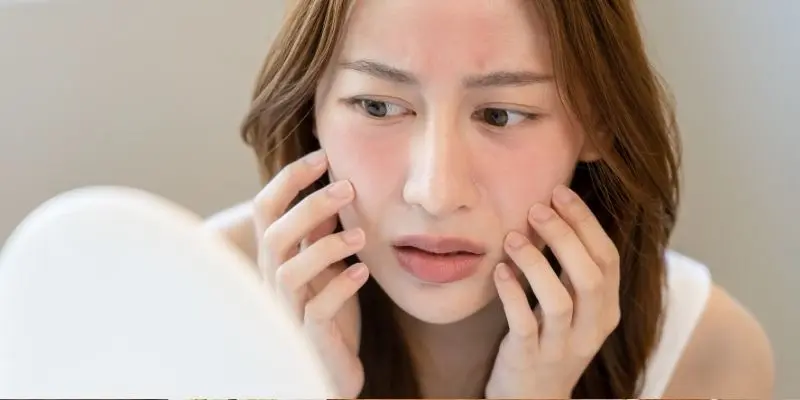“How to Get Rid of Face Redness Naturally: Simple and Effective Remedies”
Published: 18 Feb 2025
Face redness can be a frustrating skin concern, often caused by inflammation, irritation, or underlying conditions. Whether you’re dealing with acne, rosacea, or sensitivity, you don’t have to rely on harsh chemicals or expensive treatments. In this guide, we’ll share simple and effective natural remedies that can help reduce redness and soothe your skin, leaving you with a clearer, more balanced complexion.

Do you often wonder why your face turns red without any obvious cause? Whether it’s due to irritation, acne, or something else, face redness can feel overwhelming and confusing. Many people struggle to find the right solution, unsure if it’s caused by an allergy, an underlying skin condition, or something else entirely. In this guide, we’ll explore the natural remedies that can help you clear up your redness for good, providing you with simple and effective solutions that anyone can incorporate into their routine.
1. Gentle Cleansing for Calm Skin
Why it Helps:
When your skin is red or irritated, using harsh cleansers can make the problem worse by stripping the skin’s natural oils and increasing sensitivity. Gentle cleansing, on the other hand, helps maintain your skin’s natural balance while removing dirt, oil, and impurities without causing further irritation.
How to Use:
- Choose a mild, fragrance-free cleanser that is free from harsh chemicals and artificial fragrances.
- Look for calming ingredients like aloe vera, chamomile, or glycerin, which help soothe and hydrate the skin.
- Wash your face twice a day—once in the morning and once before bed—to keep your skin clean and refreshed without over-drying it.
- Avoid hot water and opt for lukewarm water to prevent additional irritation.
Tip: Always follow up with a moisturizer to lock in hydration and keep your skin feeling soft and balanced.
2. Aloe Vera: Nature’s Soothing Solution
Why it Helps:
Aloe vera is renowned for its anti-inflammatory and cooling properties, making it an excellent choice for calming redness and irritation. It helps to hydrate the skin, reduce swelling, and promote healing, making it a natural remedy for soothing irritated skin. Aloe vera also contains vitamins and antioxidants that help nourish and rejuvenate the skin.
How to Use:
- Use fresh aloe vera gel directly from the plant, or choose a store-bought gel that is pure and free from artificial additives.
- Apply a thin layer of the gel to the affected areas of your face, ensuring an even coverage.
- Leave it on for 10-15 minutes, allowing the gel to absorb into the skin. This will provide a cooling and soothing effect.
- Rinse off with lukewarm water if necessary, or leave it on as an overnight treatment for maximum hydration.
Tip: Use aloe Vera gel 2-3 times a day for best results, especially after exposure to sun or harsh weather conditions.
3. Green Tea Compress for Instant Relief
Why it Helps:
Green tea is packed with antioxidants and anti-inflammatory properties that help soothe irritated and red skin. The polyphenols in green tea can reduce inflammation, calm redness, and promote healing. Using it as a compress can bring instant relief to your skin, helping to restore a calm and balanced appearance.
How to Use:
- Brew a cup of green tea and let it cool to room temperature.
- Soak a cotton pad or clean cloth in the cooled green tea until it’s fully saturated.
- Place the compress on the affected areas of your face for 5-10 minutes, allowing the skin to absorb the soothing benefits.
- Repeat 2-3 times a day for continuous relief and improvement.
Tip: For added benefit, store the green tea compress in the fridge for a cooling effect, especially helpful for inflammation or puffiness.

4. Hydrate and Moisturize to Protect Skin
Why it Helps:
Red skin is often a sign of dehydration, and without proper hydration, your skin can become more irritated and sensitive. Moisturizing helps to lock in water and prevent your skin from losing its natural moisture. Using the right moisturizer helps maintain the skin’s barrier, so it’s less prone to redness, irritation, and dryness.
How to Use:
- Choose a hydrating moisturizer that is fragrance-free and contains ingredients like hyaluronic acid, glycerin, or ceramides to help retain moisture.
- Apply the moisturizer immediately after cleansing while your skin is still damp, which helps lock in the hydration.
- Use it twice a day—once in the morning and once before bed—for continuous hydration and protection.
- For extra relief, you can also choose a moisturizing mask or overnight treatment to give your skin a deep moisturizing boost.
Tip: If your skin is extremely dry, consider using an occlusive moisturizer like petroleum jelly to seal in moisture overnight.
5. Cool Compress to Calm Inflammation
Why it Helps:
A cool compress is an effective and simple way to reduce skin inflammation and calm redness. The cold temperature helps constrict blood vessels, which can reduce swelling and redness, providing immediate relief to irritated skin. It also helps soothe the skin by lowering the skin’s temperature, which calms down the sensation of heat often associated with redness.
How to Use:
- Soak a clean washcloth or cotton pad in cold water, or wrap some ice in a towel (don’t apply ice directly to the skin to avoid frostbite).
- Apply the cool compress gently to the red or inflamed areas for 5-10 minutes, ensuring not to press too hard.
- Repeat the process 2-3 times a day to continually soothe and calm the affected areas.
Tip: For an extra soothing effect, use chilled green tea or chamomile tea instead of just water for the compress, as these ingredients also have calming properties.
6. Use Sunscreen to Prevent Further Redness
Why it Helps:
Sun exposure is one of the primary causes of skin irritation and redness. It can worsen existing redness or trigger new flare-ups, especially if your skin is already sensitive. Sunscreen acts as a protective barrier, shielding your skin from harmful UV rays that can aggravate redness, cause sunburn, and accelerate skin aging.
How to Use:
- Choose a broad-spectrum sunscreen with an SPF 30 or higher to protect against both UVA and UVB rays.
- Apply sunscreen generously to your face and neck every morning, even on cloudy days or during the winter.
- Reapply sunscreen every 2 hours if you’re spending time outdoors or sweating.
- Opt for a sunscreen with added soothing ingredients like niacinamide or zinc oxide, which can further reduce irritation and redness.
Tip: If you have sensitive or reactive skin, go for a physical (mineral) sunscreen instead of chemical sunscreens, as they are less likely to cause irritation.
7.How to Stop Redness from Coming Back
Why it Helps:
Face redness can be persistent, but with the right precautions, you can reduce the chances of it coming back. Identifying and avoiding triggers, using the right products, and maintaining a consistent skincare routine can keep your skin calm and prevent further flare-ups.
Steps to Prevent Recurrence:
Control Stress:
Emotional stress can lead to flare-ups. Practice relaxation techniques such as meditation, yoga, or deep breathing to keep stress at bay.
Identify and Avoid Triggers:
Recognize what causes your redness—whether it’s certain foods, skincare products, or environmental factors. Avoid these triggers to prevent recurrence.
Stick to a Gentle Skincare Routine:
Use gentle, fragrance-free cleansers and moisturizers that are specifically designed for sensitive skin. Avoid harsh treatments that could irritate your skin further.
Always Apply Sunscreen:
Protect your skin from harmful UV rays that can make redness worse. Use a sunscreen with SPF 30 or higher every day, even when it’s cloudy.
Maintain Hydration:
Keep your skin moisturized to protect the skin barrier and prevent it from drying out. Dehydration can worsen redness, so always hydrate regularly.
Explanation:
Certain foods, weather conditions, or skin products can aggravate redness. Identifying your triggers can help you manage your skin more effectively. Pay attention to any foods or environmental factors that worsen redness and avoid them when possible.
8. Consult a Dermatologist for Persistent Redness
Why it Helps:
If you’ve tried various remedies and the redness persists, it may be a sign of an underlying skin condition like rosacea, eczema, or an allergy. A dermatologist can diagnose the root cause of your skin issue and recommend treatments that are tailored to your specific needs, ensuring better results and a more effective solution.
When to Consult a Dermatologist:
- If the redness doesn’t improve after trying home remedies.
- If the redness is accompanied by pain, swelling, or acne-like bumps.
- If you notice flushing or burning sensations on your face.
- If the redness affects large areas of your face and persists for weeks.
What to Expect During a Consultation:
- The dermatologist will examine your skin and may ask questions about your skincare routine, lifestyle, and medical history.
- You may be recommended topical treatments, oral medications, or specialized skincare routines depending on the severity of the redness.
- In some cases, laser treatments or other advanced therapies may be suggested to reduce persistent redness.
Tip: If you have any concerns or are unsure about your skin’s condition, it’s always best to schedule an appointment with a dermatologist to get expert advice and a personalized treatment plan.
FAQs about Internet
Here are some of the most frequently asked questions about How to Get Rid Of Face Redness.
Sudden redness on the face can be triggered by factors like stress, irritation from skincare products, or sun exposure. To stop it, avoid harsh products, use a soothing moisturizer, and apply sunscreen to protect your skin from further irritation.
No, face redness and acne are different. Redness can occur without pimples, often due to irritation or conditions like rosacea, while acne typically involves clogged pores and pimples. Treating both requires different approaches, like gentle skincare for redness and targeted acne treatments.
Yes, spicy foods can trigger redness, especially if you have sensitive skin or conditions like rosacea. They can cause blood vessels to dilate, increasing blood flow to your face, which results in redness.
Exercise can cause redness because physical activity increases blood flow, which leads to your blood vessels expanding. To minimize redness, avoid hot environments, stay hydrated, and cool down properly after exercise.
Yes, using a cold compress or ice wrapped in a cloth can help reduce inflammation and calm redness. The cold temperature constricts blood vessels, which can lower swelling and redness temporarily.
In many cases, face redness can go away on its own, especially if it’s caused by temporary triggers like heat or mild irritation. However, if it persists, you may need to consult a dermatologist for a more personalized treatment plan.
It’s best to avoid makeup if your face is red, as it can worsen irritation or block your pores. However, if you choose to wear makeup, opt for non-comedogenic and fragrance-free products designed for sensitive skin.
Yes, prolonged sun exposure can cause lasting damage, leading to persistent redness and even conditions like rosacea. Always apply sunscreen with SPF 30 or higher to protect your skin and reduce the risk of long-term redness.
If your redness is persistent, painful, or accompanied by swelling, bumps, or a burning sensation, it could be a sign of a condition like rosacea or an allergy. In such cases, it’s best to consult a dermatologist for a proper diagnosis.
Yes, staying hydrated helps maintain skin health and can prevent dehydration-related redness. Drinking enough water ensures your skin remains moisturized, which can reduce irritation and inflammation that leads to redness.
Conclusion:
Natural remedies for face redness are not only effective but also gentle on your skin. By following a consistent skincare routine, hydrating your skin, and protecting it from triggers, you can reduce redness and achieve clearer, calmer skin. Don’t let redness hold you back – embrace these simple steps for healthier, glowing skin.

- Be Respectful
- Stay Relevant
- Stay Positive
- True Feedback
- Encourage Discussion
- Avoid Spamming
- No Fake News
- Don't Copy-Paste
- No Personal Attacks



- Be Respectful
- Stay Relevant
- Stay Positive
- True Feedback
- Encourage Discussion
- Avoid Spamming
- No Fake News
- Don't Copy-Paste
- No Personal Attacks





